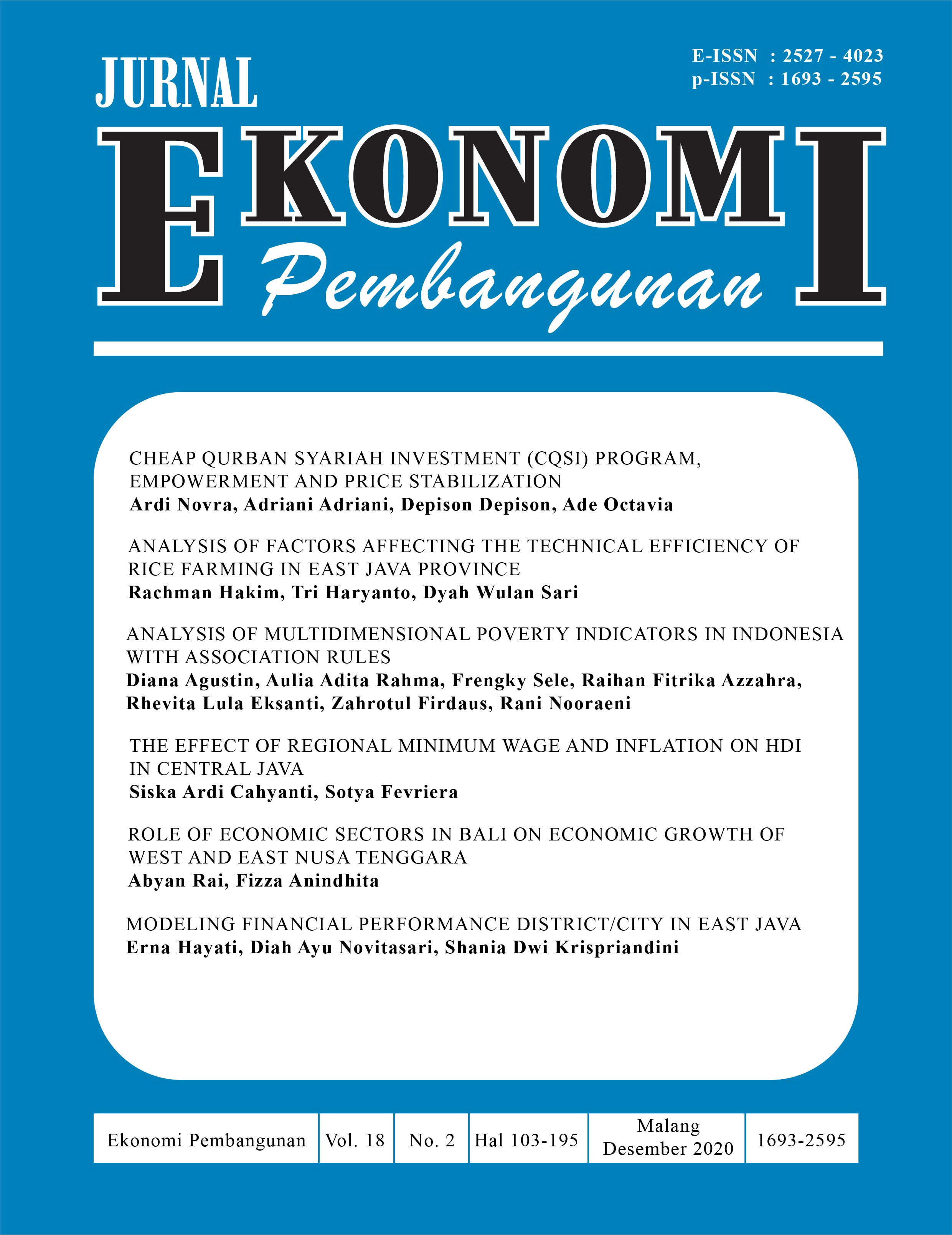Analysis of Multidimensional Poverty Indicators in Indonesia with Association Rules
DOI:
https://doi.org/10.22219/jep.v18i2.14244Keywords:
Association Rules, MCA, Poverty IndicatorsAbstract
This study was conducted to find patterns of relationships between 14 multidimensional poverty indicators in Indonesia from 2015-2019. To provide a more specific description of the relationship pattern, association rules with the apriori algorithm is used as the analysis method. The preprocessing stage to transform data was carried out using fuzzy functions and data reduction with Multiple Correspondence Analysis (MCA) to support the association analysis process. The results obtained are 15 relationship patterns or rules between items from the multidimensional poverty indicator with a support value of 60%-80% and 100% confidence. This means that the relationship pattern is significantly formed from objects with a strong relationship between the items and can represent poverty records in the last five years. The relationship pattern consists of four combinations of things. Suppose there is a high category decrease in the percentage of poor people indicator, a low category decrease in the open unemployment indicator, a high category increase in the percentage of households indicator according to the source of lighting from electricity, and a low category increase in the percentage indicator of households according to the broadest wall, not bamboo / other. In that case, there is a reduction in multidimensional poverty in Indonesia.Downloads
References
Aidha, CN. 2020. Indeks Kemiskian Multidimensi Indonesia 2015-2018. Prakarsa: Jakarta Selatan.
Alkire, S., Chatterjee, M., Conconi, A., Seth, S., & Vaz, A. (2014). Global Multidimensional Poverty Index 2014. OPHI.
Aprianti, W., Hafizd, K. A., & Rizani, M. R. (2017). Implementasi Association Rules dengan Algoritma Apriori pada Dataset Kemiskinan. Limits: Journal of Mathematics and Its Applications, 14(2), 145-155.
Arafah, A. A., & Mukhlash, I. (2015). The application of fuzzy association rule on co-movement analysis of Indonesian stock price. Procedia Computer Science, 59, 235-243.
Artha, D. R. P., and Dartanto, T. (2014). Multidimensional Approach to Poverty Measurement in Indonesia. LPEM-FEUI Working Paper No. 002.
Bappenas. (2018). Analisis Wilayah dengan Kemiskinan Tinggi. Kementrian PPN/Bappenas: Jakarta.
BPS. (2020, Juli 15). Garis Kemiskinan. Retrieved from BPS: https://www.bps.go.id/pressrelease/2020/07/15/1744/persentase-penduduk-miskin-maret-2020-naik-menjadi-9-78-persen.html
Brian, T., & Sanwidi, A. (2018). Implementasi Algoritma Apriori Untuk Market Basket Analysis Berbasis R. Jurnal ELTIKOM: Jurnal Teknik Elektro, Teknologi Informasi dan Komputer, 2(1), 1-8.
Budiantoro, S., Martha, L., & Sagala, M. (2016). Penghitungan Indeks Kemiskinan Multidimensi Indonesia 2012-2014. Prakarsa.
Ginting, D. S., Mawengkang, H., Efendi, S. (2018). Modification of the Apriori Algorithm focused on confidence value to association rules. IOP Conference Series: Materials Science and Engineering, 420, 012125.
Greenacre, M. J. (1984). Theory and Applications of Correspondence Analysis. Academic Press: London.
Greenacre, M. (2017). Correspondence analysis in practice. CRC press.
Greenacre, M., & Blasius, J. (Eds.). (2006). Multiple correspondence analysis and related methods. CRC press.
Han, J. dan M. Kamber. 2006. Data Mining Concepts and Techniques Second Edition. San Francisco: Morgan Kaufmann.
Kalayci, N., Basaran, M. A. (2014). A Combined Approach Using Multiple Correspondence Analysis and Log-linear Models for Student Perception in Quality in Higher Education, Procedia Economics and Finance, Vol 17, 55-62,
Kaur, M., Kang, S. (2016). Market Basket Analysis: Identify the Changing Trends of Market Data Using Association Rule Mining, Procedia Computer Science, 85, 78-85
Kemalbay, G., Korkmazoğlu, Ö. B. (2014). Categorical Principal Component Logistic Regression: A Case Study for Housing Loan Approval. Procedia - Social and Behavioral Sciences,109, 730-736.
Natarajan, P., Sivasankaran, S. K., Balasubramanian, V. (2020). Identification of Contributing Factors in Vehicle Pedestrian Crashes in Chennai using Multiple Correspondence Analysis. Transportation Research Procedia, 48, 3486-3495,
Pramana, S. (2018). Data Mining dengan R : Konsep Serta Implementasi. In Media.
Rani, Heena., Upadhyaya Shuchita., Kumar, Vinod. (2014). Frequent Pattern Analysis of Moving Objects Using Apriori Algorithm International. Journal of Emerging Research in Management &Technology ISSN: 2278-9359 3 (4).
Syahyuti. (2014). Mau Ini apa Itu?: Komparasi Konsep, Teori, dan Pendekatan dalam Pembangunan Pertanian dan Pedesaan. Amplitudo Media Science.
Tanna, P., & Ghodasara, D. Y. (2014). Using Apriori with WEKA for Frequent Pattern Mining. International Journal of Engineering Trends and Technology,12 (3), 127–131.
United Nations. (2020). SDGs Indicators, Metadata 1.2.2. United Nations.
World Bank. (2018). Laporan Tahunan Bank Dunia 2018. World Bank.
Downloads
Published
Issue
Section
License
Authors who publish with Jurnal Ekonomi Pembangunan (JEP) agree to the following terms:
- For all articles published in Jurnal Ekonomi Pembangunan (JEP), copyright is retained by the authors. Authors permit the publisher to announce the work with conditions. When the manuscript is accepted for publication, the authors agree to the publishing right's automatic transfer to the publisher.
- Authors retain copyright and grant the journal right of first publication with the work simultaneously licensed under a Creative Commons Attribution-NonCommercial-ShareAlike 4.0 International License that allows others to share the work with an acknowledgment of the work's authorship and initial publication in this journal.
- Authors can enter into separate, additional contractual arrangements for the non-exclusive distribution of the journal's published version of the work (e.g., post it to an institutional repository or publish it in a book), with an acknowledgment of its initial publication in this journal.
- Authors are permitted and encouraged to post their work online (e.g., in institutional repositories or on their website) before and during the submission process, as it can lead to productive exchanges and earlier and greater citation of published work (See The Effect of Open Access).

This work is licensed under a Creative Commons Attribution-NonCommercial-ShareAlike 4.0 International License.






















